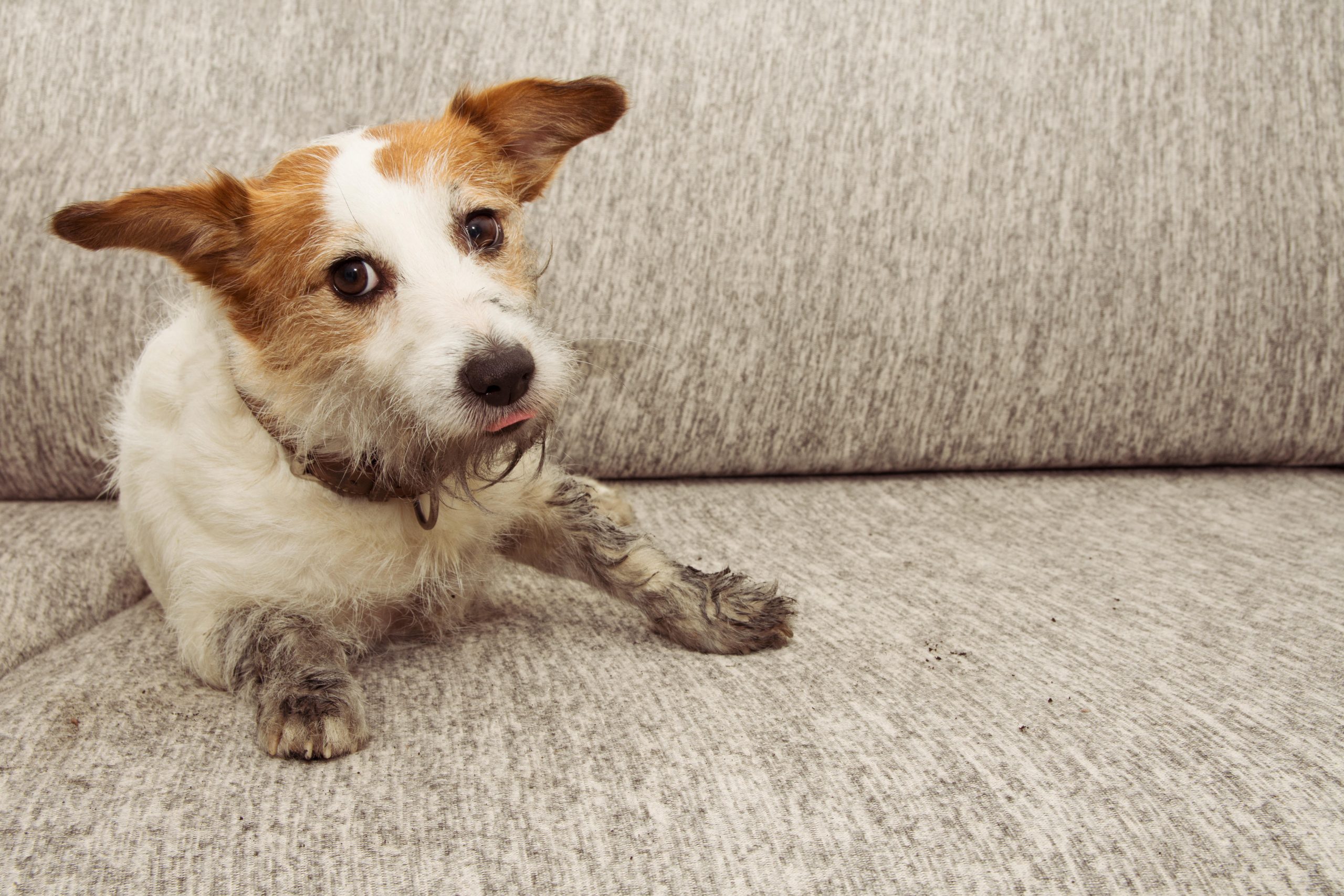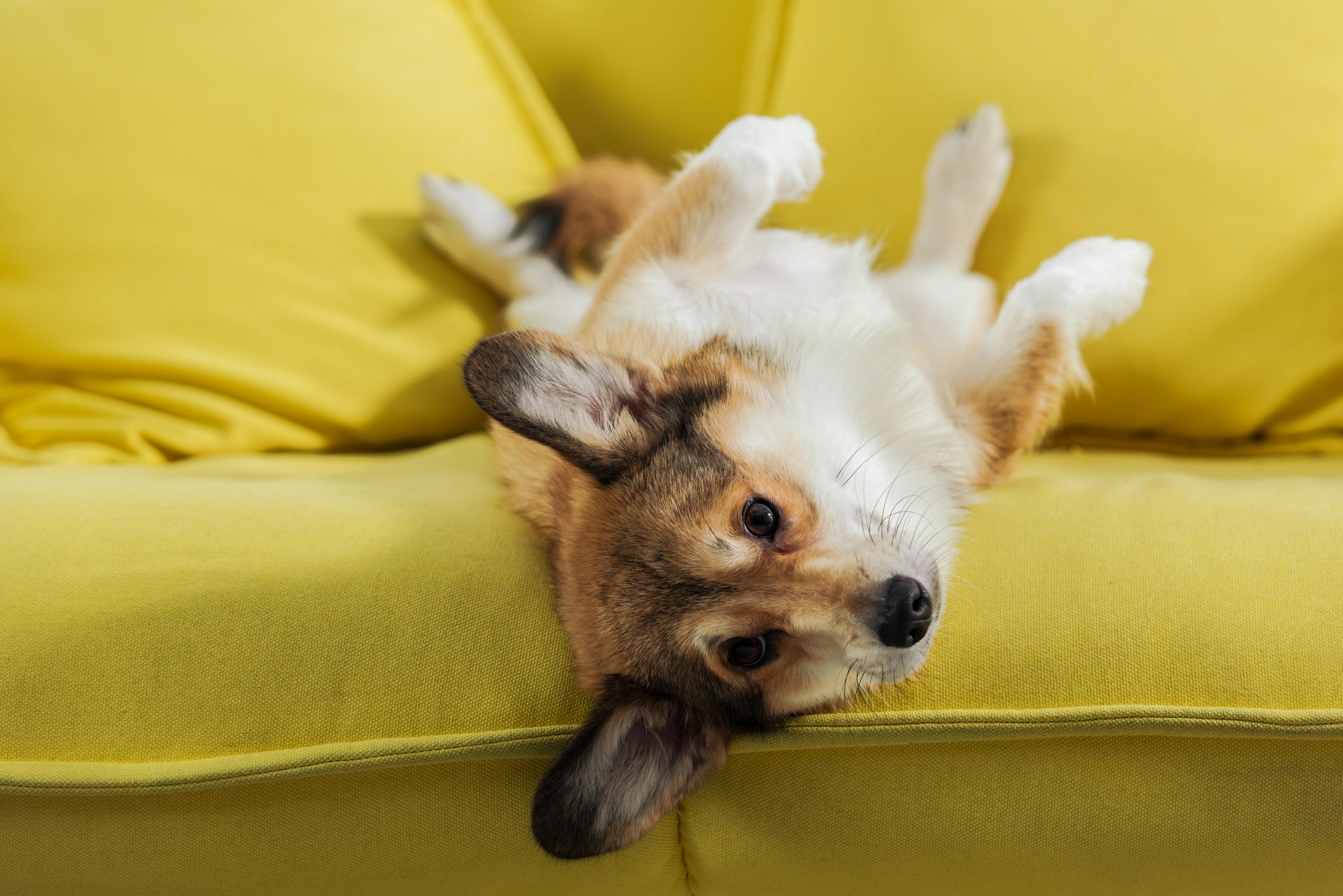How to keep a dog off the sofa, by top trainer Ben Randall
Fed up with Fido leaping onto the furniture — whether it's your sofa, armchair, or your bed — whenever he or she fancies it and leaving a trail of muddy pawprints — not to mention a layer of dog hair — in their wake? Celebrity dog-trainer Ben Randall explains how to keep a dog off the sofa.


I'm going to be up front with this one: I’m always happy for my dogs to be on the sofa with me, especially on a winter’s evening in front of the log burner. However, this must always be by invitation only, and I recognise that not every dog owner is the same on this score. Suffice to say that this is an article that I will definitely be asking my wife, Nikki (as well as Country Life’s own Paula Lester) to read thoroughly!
A dog that uses the couch like a bed can be a particular problem if they’re wet and muddy or you have guests who don’t want your pooch on their lap — and that's the issue faced by S.D. from Cornwall, who wrote in with this week's problem:
‘Although I adore my two chocolate Labradors, I’ve made a rod for my own back by letting them up on the sofa. How do I persuade them that the comfy bed they have on the floor beside it is a better option?’
This is a tricky question, since it's not unwanted behaviour of the sort that I've addressed in the past — things like training your dog to stop jumping up on people, stopping your dog stealing food or getting your dog to stop barking at the door. Nor is it a regular routine that we're instilling, as you might with puppy crate training, introducing the lead. It's a little more subtle than any of that — but it's exactly the sort of thing I've been working on with my Beggarbush training methods for the last two decades. You can get a free trial of my dog training app if you want more tips, and if you've got your own question you can email paws-for-thought@futurenet.com.

Basically, we're happy to share our homes with our dogs — but that doesn't mean we can't have a few ground rules, and stopping your dog getting up on the sofa can be one of them if you follow these tips.
Five steps to keep your dog off the sofa
1. Make sure you have a bed for your dog to lie in
I like to give our indoor dogs (a Border terrier, a Bavarian mountain hound and a retired working labrador) a place in each location they’re allowed in, where they can go to settle and be calm and relaxed in. So, for example — depending on how many dog beds we have in the house — when I decide to go into the lounge, I take their beds with me, then call them through and tell them to go into their beds.
How do we stop a dog leaving its area and jumping up on the sofa for attention? The two commands I use are ‘leave’ followed by a hand direction (you can read more here about how to get a dog to leave things), and pointing at the bed or place you want your dog to go to and saying ‘in’.
2. Go back a few training steps if your dog doesn’t do as you ask
If your dog is not responding to these commands, then it’s simple: they don’t understand the instructions well enough and you need to revisit that section of their foundation training.
Exquisite houses, the beauty of Nature, and how to get the most from your life, straight to your inbox.
I usually teach my clients a routine to try once their dogs have come into the lounge. The owners should hold their dog's bed (or dogs' beds), ask them to sit, then place the bed(s) in the chosen area they want their dogs to relax in. Then, they call the dog to their bed (and if there are several, call each one individually) before rewarding the dog with a piece of kibble for their good behaviour. This way, when the dog sees its bed — irrespective of the location it’s in — he or she knows it’s a good, positive place to be.

This is also a good tip if you go away anywhere. I once went to a hotel with my Labrador Nell, but hadn’t taken a dog bed with me, so I took the fluffy shower mat from the bathroom and placed it in the corner of the room, told her to lie on it and she slept on it all night. This is a real advantage, especially when you’re away from home — for example, staying at a hotel or with friends or family — and giving your dog his or her space is important and beneficial.
When my brother and sister-in-law come to visit with their dog, the first thing they do is bring the dog’s bed into the kitchen and ask their liver cocker, Purdey, to go into it. That way, Purdey’s happy and they’re happy — they know she’s calm and settled.
3. Letting your dog have his own way will make it more disobedient
Allowing your dog to regularly get on the sofa will make the situation harder, as he or she will expect to be there, rather than be asked to be there. This is true in our house, too. When my wife, Nikki, and I head into the lounge of an evening, I tend to sit down first and all the dogs are looking at me with those eyes requesting a cuddle that’s indicative of the lovely respect and partnership between us.
Then, as my wife comes in and sits down, they all dive on her, because they don’t respect her space as much as they do mine. The fact that they jump on the sofa like this with her also transfers into the fact that they don’t really behave with her in other areas of their life. For example, when Nikki takes them out for a walk, they don’t always behave in the same well-mannered way that they would if I was taking them out.
4. How to keep a dog off the sofa if you’ve always allowed it? Practice, practice, practice
If you’ve previously allowed your dog onto the sofa and you’ve now decided it’s not a good idea — maybe because you want to have some supper or a drink in peace or you’ve got some friends coming round — you'll have to work at it. As with all behaviour changes, we must regularly practise the new regime to get the desired results.
In an ideal world, while the dog is sitting on the sofa, you’d point to his bed and say: ‘Bertie, in!’ What happens if Bertie won’t go into his bed? As previously mentioned, it’s important that the dog knows its name and understands that, if he or she follows the command, they’re going to a positive place where they will be rewarded.

5. If they’re too excitable to listen to commands, accept that they're not ready for this stage of training
If your dog or dogs are getting really excited, jumping in and out of their beds and running back and forth, this is a clear sign they’re not yet ready to be in this environment, especially with other people, food and drink, etc.
The best way to restart this process is again by using their bed and, when they’re sitting in it, to place a food reward on the floor next to their bed, thereby giving them a good reason to sit and watch that kibble. Then, every so often, I walk past the bed, lean down and reward the dog with a piece of kibble. The point of having the reward in that particular spot is so that the dog can clearly see it, which gives him or her a reason to start in a positive place; but, ultimately, learning to ignore any distractions because they soon realise that, by staying in their beds, they will earn that reward.
As the dog gets used to doing this, after a week or so they’re happy to go into their bed and to stay there for the duration of the film or the time you stay in the lounge, as they know that a reward will always come their way, whether that be praise and an ear scratch or a piece of kibble from you.
For more detailed advice about Ben Randall’s positive, reward-based and proven BG training methods, one-to-one training sessions, residential training or five-star dog-boarding at his BGHQ in Herefordshire, telephone 01531 670960 or visit www.ledburylodgekennels.co.uk. For a free seven-day trial of the Gundog app, which costs £24.99 a month or £249.99 a year, visit www.gundog.app/trial
